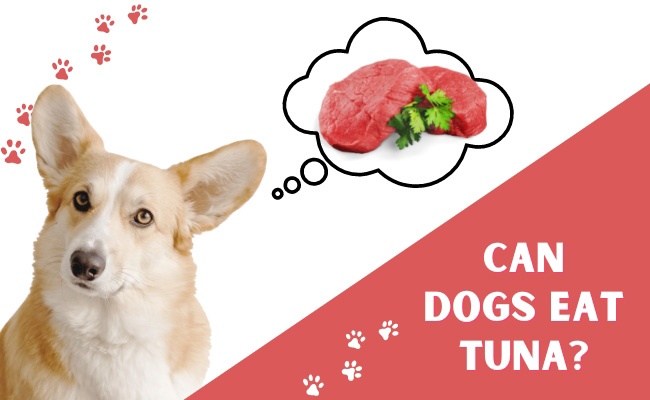
When it comes to the dietary needs of our canine companions, the waters can sometimes get a bit murky—especially when we consider the inclusion of seafood in their diet. Among the various options, tuna is a topic of considerable debate. This versatile fish, known for its robust flavor and packed with nutrients, sits on many human dinner plates. But does it belong in our dogs’ bowls?
Understanding canine nutrition is pivotal to ensuring the longevity and vitality of our beloved pets. With this article, we aim to dive deep into the heart of the matter, exploring whether dogs can safely eat tuna. We’ll examine the nutritional benefits of this popular fish, weigh the potential risks, and offer guidance from veterinary experts. Our goal is to provide dog owners with vet-reviewed information, enabling them to make informed decisions about including tuna in their pet’s diet.
In the journey of pet ownership, ensuring the health and happiness of our furry friends is paramount. As we explore the possibilities and precautions of feeding tuna to dogs, we invite you to join us in understanding more about what’s best for your loyal companion’s nutritional needs.
Can Dogs Eat Tuna?
Yes, dogs can eat tuna, but it should be offered in moderation and with certain precautions in mind. Tuna provides beneficial nutrients like omega-3 fatty acids and protein, which can support a dog’s overall health, including their skin, coat, and joint health. However, there are several considerations to ensure that feeding tuna to your dog is safe:
- Mercury Content: Tuna contains mercury, which can accumulate over time and potentially lead to mercury poisoning. Symptoms include loss of coordination, vision problems, and kidney failure. To minimize the risk, tuna should be given only occasionally and in small amounts.
- Preparation: If feeding fresh tuna, it should be cooked thoroughly without any added oils, seasonings, or spices that could be harmful to dogs. Canned tuna should be in water, not oil, and it’s preferable to choose low-sodium options.
- Portion Size: Treats, including tuna, should not make up more than 10% of your dog’s daily caloric intake to maintain a balanced diet and prevent nutritional imbalances.
- Consultation with a Veterinarian: Before introducing tuna or making any significant changes to your dog’s diet, consulting with a veterinarian is crucial. They can offer guidance based on your dog’s specific dietary needs and health status.
In summary, while dogs can safely eat tuna in moderation, it’s essential to consider the potential risks, such as mercury exposure, and to prepare it safely. Always consult with a veterinarian to ensure that adding tuna to your dog’s diet is appropriate for their individual health needs.
Table of Contents
- Can Dogs Eat Tuna?
- The Nutritional Value of Tuna for Dogs
- Risks of Feeding Tuna to Your Dog
- Safe Feeding Guidelines
- Preparing Tuna for Your Dog
- Can Dogs Have Canned Tuna?
- Canned Tuna vs. Fresh Tuna for Dogs
- Can Dogs Eat Raw Tuna?
- Can Puppies And Pregnant Dogs Eat Tuna?
- Which Types of Fish Can Dogs Eat Safely?
- Mixing Tuna with Dog Food: Is it a Good Idea?
- FAQ:
The Nutritional Value of Tuna for Dogs
Tuna is a nutrient-dense fish that can offer several health benefits for dogs when included in their diet in moderation and under the guidance of a veterinary professional. Here’s a closer look at the nutritional components found in tuna and their potential benefits:
Types of Nutrients Found in Tuna
- Protein: Tuna is an excellent source of high-quality protein, which is crucial for the growth, repair, and maintenance of body tissues in dogs. Protein is a foundational element of a healthy canine diet, supporting everything from muscle development to immune function.
- Omega-3 Fatty Acids: One of the most beneficial components found in tuna is omega-3 fatty acids, particularly EPA (eicosapentaenoic acid) and DHA (docosahexaenoic acid). These fatty acids play a vital role in canine health.
- Vitamins and Minerals: Tuna contains a variety of vitamins and minerals essential for dogs, including vitamin B12, selenium, and potassium. These nutrients support various bodily functions, including cognitive health, immune response, and thyroid function.
Benefits of Omega-3 Fatty Acids for Dogs
Omega-3 fatty acids are particularly noteworthy for their extensive health benefits, including:
- Skin and Coat Health: Omega-3s can help improve skin health, leading to a shinier and healthier coat. They are beneficial for dogs suffering from skin allergies or dryness.
- Joint Health: These fatty acids have anti-inflammatory properties that can be particularly beneficial for dogs with arthritis or other joint issues, helping to reduce pain and increase mobility.
- Heart Health: Omega-3s can contribute to heart health by regulating blood pressure, reducing triglycerides, and improving overall cardiovascular function.
- Cognitive Function: DHA, a type of omega-3 fatty acid, is essential for brain development in puppies and can support cognitive function in older dogs, helping to stave off cognitive decline.
While tuna can be a valuable source of nutrients for dogs, it’s crucial to approach its inclusion in your dog’s diet with care. Due to concerns about mercury content and other potential risks, it’s advisable to serve tuna in moderation and opt for varieties that are lower in mercury. Always consult with a veterinary professional before making significant changes to your dog’s diet, to ensure that any new food supports their overall health and nutritional needs.
In summary, when fed appropriately, tuna can offer a range of health benefits for dogs, thanks to its rich nutritional profile, particularly the presence of omega-3 fatty acids. However, it’s essential to balance these benefits with caution regarding portion size and frequency to ensure the utmost health and wellbeing of our canine companions.
Risks of Feeding Tuna to Your Dog
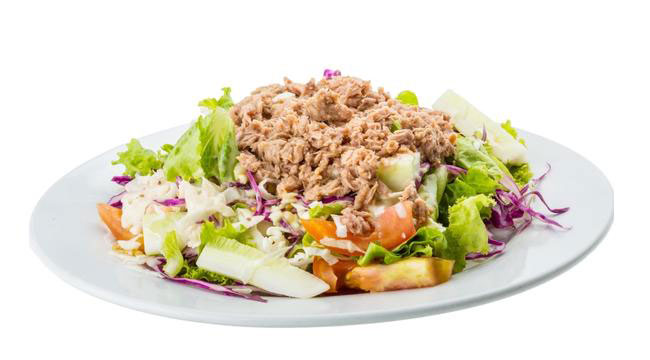
As veterinarians, our primary concern is the health and well-being of pets, so it’s essential to approach the topic of feeding tuna to dogs with a balanced view, considering not only the potential benefits but also the risks involved. Here are some of the potential risks associated with feeding tuna to dogs:
Mercury Content in Tuna and Its Effects on Dogs
One of the most significant concerns with feeding tuna to dogs is the mercury content. Mercury is a heavy metal that, in high levels, can be toxic to both humans and animals. Fish accumulate mercury in their bodies over time, and larger species like some types of tuna tend to have higher concentrations.
In dogs, chronic exposure to mercury can lead to mercury poisoning, with symptoms including:
- Loss of coordination and balance
- Loss of hair or skin lesions
- Kidney damage (potentially leading to kidney failure)
- Gastrointestinal upset
- Nervous system problems, such as tremors or changes in behavior
The Risk of Salt and Seasonings in Canned Tuna
Canned tuna, while a convenient option, often contains added salt or seasonings to enhance flavor. High sodium intake is not advisable for dogs, as it can lead to:
- Increased blood pressure
- Dehydration
- Sodium ion poisoning in severe cases, characterized by symptoms such as vomiting, diarrhea, excessive thirst or urination, lethargy, and incoordination
Furthermore, seasonings and additives (such as garlic and onion, which are toxic to dogs) can pose additional risks, making some canned tuna products unsuitable for canine consumption.
Possible Allergic Reactions to Seafood in Dogs
While seafood allergies are less common in dogs than in humans, they can still occur. Dogs with a seafood allergy may exhibit symptoms such as:
- Itchy skin
- Gastrointestinal upset, including vomiting and diarrhea
- Ear infections
- Swelling of the face, ears, lips, eyelids, or earflaps
If you notice any of these symptoms after feeding your dog tuna for the first time, it’s crucial to stop feeding them the fish and consult with a veterinarian promptly.
As a vet, I would advise dog owners to exercise caution when considering adding tuna to their dog’s diet. While tuna can offer health benefits due to its nutrient content, the risks associated with mercury, added salt and seasonings, and potential allergic reactions cannot be overlooked. If you decide to feed your dog tuna, opt for varieties low in mercury and without added salt or seasonings. It’s also essential to introduce it into their diet gradually and in moderation, monitoring for any adverse reactions. Always consult with your veterinarian before making significant changes to your pet’s diet, especially if your dog has pre-existing health conditions or dietary restrictions.
Related Post: Best Dog Food Review 2023 (Large Breed & Small Breed)
Safe Feeding Guidelines
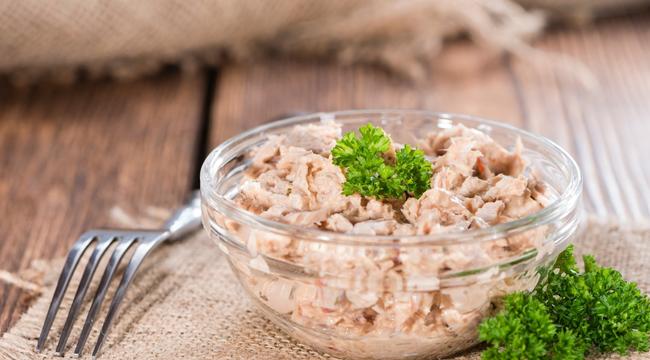
Recommended Portions Based on Dog Size and Weight
The size and weight of your dog significantly influence the appropriate serving size of tuna. As a general rule, tuna should be considered a treat rather than a staple of their diet. Treats should not make up more than 10% of a dog’s daily caloric intake to maintain a balanced diet.
- Small dogs (up to 20 pounds): A teaspoon of cooked, plain tuna once a week is sufficient.
- Medium dogs (21 to 50 pounds): Up to a tablespoon of cooked, plain tuna weekly can be appropriate.
- Large dogs (over 50 pounds): A maximum of two tablespoons of cooked, plain tuna weekly is recommended.
These portions are guidelines and might need adjustments based on the dog’s overall diet, health status, and activity level.
Frequency of Feeding Tuna to Dogs
Tuna should be fed sparingly, considering its potential mercury content and the nutritional balance of your dog’s diet. A good starting point is to include tuna as a special treat rather than a regular part of their meals. Once a week or even less frequently is advisable, especially for dogs that are more susceptible to dietary changes or those with a smaller body mass.
The Importance of Consulting with a Vet
Every dog is unique, with specific nutritional needs and health considerations. Before introducing tuna or any new food into your dog’s diet, it’s crucial to consult with your veterinarian. This is especially important for:
- Dogs with pre-existing health conditions
- Dogs on a special diet
- Puppies, pregnant or nursing dogs, and senior dogs, as their nutritional needs are different
Your vet can provide personalized advice based on your dog’s health history, weight, and dietary needs, ensuring that any addition to their diet supports their overall health and well-being.
In short, Incorporating tuna into your dog’s diet can provide them with beneficial nutrients, especially omega-3 fatty acids. However, it’s essential to do so with an understanding of the appropriate portions and frequency to avoid potential health risks. Always prioritize your dog’s nutritional balance and consult with your veterinarian before making dietary changes. This approach ensures that your furry friend can enjoy the benefits of tuna safely and healthily.
Read More: Get Ready to Fall in Love: 15 Teddy Bear Dogs that Will Melt Your Heart!
Preparing Tuna for Your Dog
As a veterinarian and dog Dietitian, ensuring the safety and nutritional appropriateness of your dog’s meals is paramount. When it comes to feeding tuna to your dog, how it’s prepared can significantly impact its safety and nutritional benefits. Here’s a comprehensive guide on preparing tuna for your dog and understanding the potential dangers of raw fish and sushi.
Choose the Right Type of Tuna
- Opt for fresh or frozen tuna that’s meant for cooking rather than canned tuna, which can contain high levels of sodium and other additives harmful to dogs.
- If using canned tuna, select no-salt-added varieties and ensure it’s packed in water, not oil.
Cooking the Tuna
- Cook tuna thoroughly without any added oils, seasonings, or spices. Dogs’ digestive systems are sensitive to the rich flavors and compounds in many seasonings, which can cause gastrointestinal upset.
- Avoid using garlic or onions in any form, as these are toxic to dogs, even in small quantities.
- Cooking can be done by boiling, baking, or grilling the tuna, ensuring it’s cooked all the way through to kill any potentially harmful bacteria or parasites.
Serving the Tuna
- Let the tuna cool down before offering it to your dog to avoid burns or discomfort.
- Cut the tuna into small, manageable pieces to prevent choking hazards, especially for smaller dogs.
- Introduce tuna into your dog’s diet gradually to monitor for any adverse reactions or allergies.
The Dangers of Raw Fish and Sushi for Dogs
Feeding raw fish or sushi to dogs poses several risks, including:
Parasites and Bacteria
- Raw fish can carry parasites and bacteria like Salmonella and Listeria, which can cause serious gastrointestinal and systemic infections in dogs. Cooking fish thoroughly is crucial to eliminate these harmful pathogens.
Thiaminase
- Some fish contain the enzyme thiaminase, which breaks down thiamine (vitamin B1). Consuming raw fish that contains thiaminase can lead to a thiamine deficiency in dogs, resulting in loss of appetite, seizures, and in severe cases, death.
Bones
- Raw fish may contain small bones that pose choking hazards or can cause internal blockages or perforations in dogs.
While tuna can be a nutritious addition to your dog’s diet when fed in moderation, it’s crucial to prepare it correctly to ensure its safety. Always cook tuna thoroughly and serve it plain, without any harmful additives or seasonings. Avoid feeding raw fish or sushi to dogs due to the significant health risks involved. As with any dietary changes or introductions, consult with your veterinarian to ensure it aligns with your dog’s specific health needs and dietary requirements.
Can Dogs Have Canned Tuna?
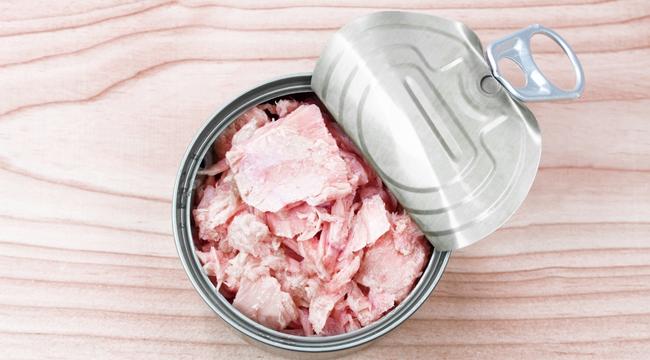
Yes, dogs can have canned tuna, but there are several important considerations to ensure it’s a safe and healthy treat:
Choose the Right Type of Canned Tuna
- Opt for canned tuna in water, not oil. Tuna canned in oil can introduce too much fat into your dog’s diet, potentially leading to pancreatitis or obesity.
- Select low-sodium or no-salt-added varieties to avoid excess sodium intake, which can be harmful to dogs.
Moderation is Key
- Tuna should be given as an occasional treat, not as a regular part of your dog’s diet. Treats, including canned tuna, should make up no more than 10% of your dog’s daily caloric intake.
Be Mindful of Mercury Content
- Tuna contains mercury, which can accumulate in the body over time and lead to mercury poisoning. Small, infrequent portions are essential to minimize this risk.
Preparation and Serving Tips
- Drain the tuna thoroughly to remove as much water or oil as possible before serving.
- Avoid tuna with added flavors or seasonings, as some ingredients like onions or garlic are toxic to dogs.
- Introduce tuna gradually into your dog’s diet to monitor for any adverse reactions or allergies.
Consult Your Veterinarian
Before introducing canned tuna or making any significant changes to your dog’s diet, it’s always best to consult with your veterinarian. They can provide personalized advice based on your dog’s specific health status, dietary needs, and any existing conditions.
Canned Tuna vs. Fresh Tuna for Dogs
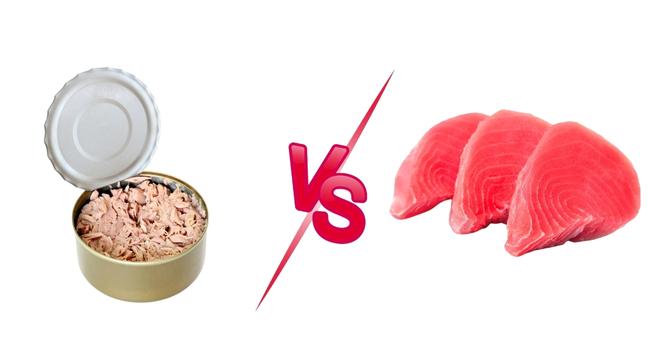
When considering incorporating tuna into your dog’s diet, you may wonder whether canned tuna or fresh tuna is the better option. Both forms of tuna can provide nutritional benefits for dogs, but they also come with specific considerations. Let’s explore the differences between canned tuna and fresh tuna for dogs, including their benefits and drawbacks.
Canned Tuna for Dogs
Benefits:
- Convenience: Canned tuna is readily available and easy to store, making it a convenient option for dog owners.
- Omega-3 Fatty Acids: Like fresh tuna, canned tuna is a source of omega-3 fatty acids, which can support skin, coat, and joint health.
Considerations:
- Mercury Content: Both canned and fresh tuna contain mercury, but levels can vary depending on the type of tuna (e.g., light tuna typically has less mercury than albacore or white tuna). It’s crucial to limit the amount and frequency of tuna fed to dogs to minimize mercury exposure.
- Sodium Content: Many canned tunas are high in sodium, which can be harmful to dogs in excess. Opt for low-sodium or no-salt-added varieties and rinse the tuna to remove some of the sodium.
- Additives: Avoid canned tuna with added seasonings, vegetables, or oils that can be harmful or too rich for dogs.
Fresh Tuna for Dogs
Benefits:
- Control over Preparation: Fresh tuna allows you to control how the fish is prepared, ensuring it’s cooked without harmful seasonings or oils.
- Lower Risk of Additives: Cooking fresh tuna for your dog means you can avoid the additives and high sodium levels often found in canned options.
- Nutrient Retention: Fresh tuna, when properly cooked, can retain more of its natural nutrients compared to some canned varieties that may lose nutrients through the canning process.
Considerations:
- Mercury Content: As with canned tuna, fresh tuna contains mercury. It’s essential to serve it in moderation and choose smaller tuna species, which generally have lower mercury levels.
- Preparation Time and Cost: Fresh tuna can be more expensive than canned tuna and requires time to prepare safely for your dog’s consumption.
- Risk of Parasites: Raw or undercooked fresh tuna can harbor parasites and bacteria harmful to dogs. Always cook fresh tuna thoroughly before feeding it to your dog.
Both canned and fresh tuna can be part of a healthy diet for dogs when served appropriately and in moderation. The key is to choose low-mercury options, avoid added sodium and seasonings, and ensure fresh tuna is cooked thoroughly to eliminate any parasites. Always consider your dog’s overall diet and health, and consult with your veterinarian before introducing new foods like tuna. This ensures that any additions to your dog’s diet support their health and nutritional needs.
Can Dogs Eat Raw Tuna?
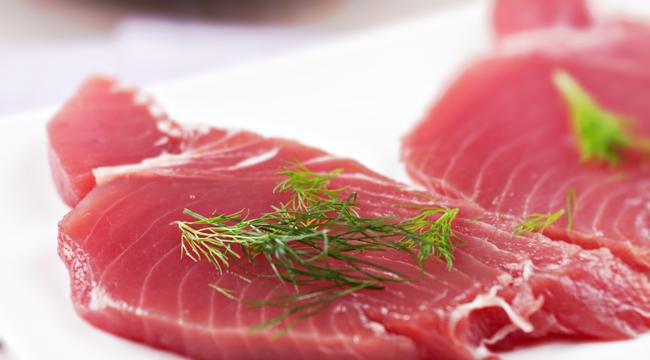
Feeding raw tuna to dogs is not recommended. While raw fish is a common component of some diets, raw tuna specifically poses several risks to dogs. Here are the main concerns associated with feeding raw tuna to dogs:
Risk of Parasites
Raw tuna can harbor parasites such as roundworms, which can infect dogs if consumed. These parasites can cause health issues ranging from gastrointestinal discomfort to more serious conditions requiring veterinary intervention.
Mercury Exposure
Tuna, whether raw or cooked, contains mercury. However, the focus on cooking the tuna isn’t about mercury reduction (as cooking does not decrease mercury levels) but about parasite and bacteria control. Still, it’s important to be aware of the mercury content in tuna and limit its intake to avoid mercury poisoning.
Bacteria and Pathogens
Like all raw meats, raw tuna can contain harmful bacteria and pathogens, such as Salmonella and Listeria, which can lead to foodborne illnesses in dogs. Cooking tuna properly kills these harmful organisms, making the fish safer for consumption.
Thiaminase Activity
Some fish, including certain types of tuna, contain thiaminase, an enzyme that breaks down thiamine (vitamin B1). While thiaminase is inactivated by cooking, in raw fish, it can lead to a thiamine deficiency in dogs, which is a vital nutrient for their health. Symptoms of thiamine deficiency include loss of appetite, seizures, and in severe cases, death.
Nutritional Imbalance
Relying heavily on raw tuna or any single type of fish can lead to nutritional imbalances in dogs. A balanced diet that meets all their nutritional needs is crucial for their overall health.
Considering the risks associated with parasites, bacteria, and the potential for nutritional imbalances, it is advisable to avoid feeding raw tuna to dogs. If you choose to include tuna in your dog’s diet, it should be cooked thoroughly (without any harmful oils or seasonings) and offered in moderation as part of a balanced diet. Always consult with your veterinarian before introducing new foods into your dog’s diet, especially raw foods, to ensure it’s safe and appropriate for your specific dog’s health needs and dietary requirements.
Can Puppies And Pregnant Dogs Eat Tuna?
When it comes to feeding tuna to puppies and pregnant dogs, caution and moderation are key. Both groups have specific nutritional needs and are more vulnerable to certain health risks associated with consuming tuna.
Puppies
Nutritional Needs
Puppies are in a crucial stage of growth and development, requiring a balanced diet rich in proteins, fats, vitamins, and minerals. While tuna can be a source of protein and omega-3 fatty acids, it should not replace a complete and balanced puppy food designed to support their developmental needs.
Mercury Concerns
Due to their smaller size and developing systems, puppies are more susceptible to the negative effects of mercury, a contaminant found in various fish, including tuna. High mercury exposure can impact a puppy’s nervous system development and overall health.
Feeding Recommendation
If you decide to feed tuna to a puppy, it should only be a tiny amount, cooked (never raw), and free from bones, oils, and seasonings. It’s best to consult with a veterinarian before introducing tuna into a puppy’s diet, ensuring it doesn’t disrupt their nutritional balance or introduce health risks.
Pregnant Dogs
Nutritional Needs
Pregnant dogs have increased nutritional demands to support fetal development and, later, lactation. While omega-3 fatty acids found in tuna can benefit fetal brain and eye development, the risks associated with mercury content and dietary imbalances must be carefully weighed.
Mercury Concerns
Mercury exposure during pregnancy can pose risks not just to the mother but also to the developing fetuses. It’s crucial to minimize any potential mercury intake by choosing fish known for lower mercury levels if fish is to be included in the diet at all.
Feeding Recommendation
For pregnant dogs, the safest approach is to maintain a well-balanced diet formulated for pregnancy and lactation. If tuna is to be included, it should be in very small amounts, cooked, and only after consulting with a veterinarian to ensure it’s safe for the pregnant dog and her developing puppies.
Both puppies and pregnant dogs can be more vulnerable to the potential risks associated with eating tuna, such as mercury exposure and nutritional imbalances. While small amounts of cooked tuna may be safe on occasion, it’s essential to prioritize a diet that meets their specific nutritional needs during these critical life stages. Always consult with a veterinarian before introducing tuna or any new food into their diet to ensure it supports their health and development optimally.
Which Types of Fish Can Dogs Eat Safely?
Incorporating fish into your dog’s diet can offer a variety of health benefits, including omega-3 fatty acids, high-quality protein, and essential vitamins and minerals. However, not all fish are equally safe for dogs. Here’s a guide to the types of fish that are generally safe for dogs to eat, along with preparation tips to ensure their safety and health.
Safe Fish for Dogs
Salmon
- Benefits: Rich in omega-3 fatty acids and protein, salmon can support your dog’s immune system, skin, and coat health.
- Preparation: Always cook salmon thoroughly to kill the parasite that causes salmon poisoning disease, which is fatal if not treated.
Sardines
- Benefits: Sardines are low in mercury due to their short lifespan and small size. They’re also a good source of omega-3 fatty acids, calcium, and vitamin D.
- Preparation: Opt for sardines packed in water without added salt. No need to cook if they’re canned, but fresh sardines should be cooked.
Mackerel
- Benefits: Another excellent source of omega-3 and protein. Mackerel (especially smaller, younger fish) can be a nutritious addition to your dog’s diet.
- Preparation: Choose fresh or frozen mackerel and cook it thoroughly before serving.
Whitefish
- Benefits: Whitefish like cod, haddock, and flounder are low in fat and calories, making them a good option for dogs on a calorie-controlled diet.
- Preparation: Cook without harmful oils or seasonings. Ensure all bones are removed to prevent choking.
Arctic Char
- Benefits: Similar to salmon and trout, Arctic char is rich in omega-3 fatty acids but typically has a lower mercury content.
- Preparation: Fully cook the fish before serving it to your dog.
Fish to Avoid
- Tuna: Due to its higher mercury content, it should be fed sparingly if at all.
- Tilefish, shark, swordfish, and king mackerel: These are high in mercury and not recommended for dogs.
- Raw Pacific salmon, trout, and related species: They can carry a parasite that causes salmon poisoning disease, which is potentially fatal to dogs if untreated.
General Feeding and Preparation Tips
- Cook Fish Thoroughly: Cooking fish kills parasites and bacteria that can cause illness. Never feed your dog raw or undercooked fish.
- Remove Bones: Fish bones can be a choking hazard and may cause internal blockages or perforations. Always ensure the fish is deboned before offering it to your dog.
- Serve in Moderation: Fish should be a treat or a part of a balanced diet, not the mainstay. Consult with a veterinarian to incorporate fish into your dog’s diet correctly, ensuring they get a balanced intake of nutrients.
- Avoid Seasonings and Oils: Cook fish plain, without adding any seasonings, butter, or oil that can be harmful or upset your dog’s stomach.
Incorporating the right types of fish into your dog’s diet can enhance their nutritional intake. However, it’s essential to choose fish low in mercury, prepare it safely, and feed it in appropriate amounts as part of a well-balanced diet. Always consult with your veterinarian before making significant changes to your pet’s diet to ensure it aligns with their health needs.
Mixing Tuna with Dog Food: Is it a Good Idea?

Mixing tuna with dog food can be a good idea, under certain conditions and when done correctly. Tuna can offer additional nutrients to your dog’s diet, such as omega-3 fatty acids, protein, and vitamins. However, there are several important considerations to keep in mind to ensure this addition benefits your dog’s health without introducing risks.
Benefits of Adding Tuna to Dog Food
- Enhanced Palatability: Tuna can make meals more appealing to dogs, particularly those with picky appetites.
- Omega-3 Fatty Acids: These are beneficial for skin and coat health, cardiovascular health, and can have anti-inflammatory effects.
- High-Quality Protein: Tuna is a good source of protein, which is essential for muscle maintenance and overall health.
Considerations for Mixing Tuna with Dog Food
Mercury Content
- Tuna, especially certain types like albacore, can contain higher levels of mercury. It’s important to limit the amount of tuna your dog consumes to minimize mercury exposure.
Sodium Content
- If using canned tuna, choose varieties that are low in sodium and packed in water, not oil. High sodium content can be harmful to dogs.
Portion Control
- Tuna should not replace a significant portion of your dog’s regular diet but rather complement it. Treats and additions like tuna should make up no more than 10% of your dog’s total daily caloric intake to maintain a balanced diet.
Frequency
- Given the concerns about mercury and maintaining a balanced diet, tuna should be added to your dog’s food occasionally, not daily.
Preparation
- Ensure any tuna added to dog food is cooked (if fresh) and free from bones, oils, and seasonings that could harm your dog.
How to Safely Add Tuna to Dog Food
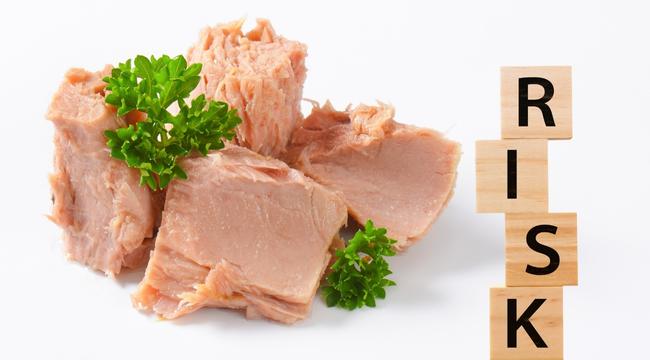
- Start Small: Begin with a small amount of tuna to see how your dog reacts. This can also help you monitor for any signs of food allergies or sensitivities.
- Mix Well: Ensure the tuna is well mixed with your dog’s regular food to encourage them to eat their entire meal rather than picking out just the tuna.
- Observe: Watch for any changes in your dog’s behavior, appetite, or digestion, and discontinue if any adverse reactions occur.
In short, Adding tuna to your dog’s food can be a way to enhance their diet with additional nutrients and variety. However, it should be done with caution, considering the potential risks related to mercury and sodium content. Always consult with your veterinarian before introducing new foods into your dog’s diet, especially if your dog has specific health conditions or dietary needs. This ensures that any changes contribute positively to their overall health and well-being.
FAQ:
Can Dogs Eat Tuna Steaks?
Yes, dogs can eat tuna steaks, but like any other type of tuna or fish, it should be given in moderation and prepared correctly to ensure it’s safe for your dog. Here are some guidelines to consider when feeding tuna steaks to dogs:
Preparation and Cooking
- Cook Thoroughly: Always cook tuna steaks thoroughly without adding any harmful oils, seasonings, or spices that could upset your dog’s stomach or be toxic to them. Raw tuna can contain parasites and bacteria harmful to dogs.
- Cool Before Serving: Let the tuna steak cool down to avoid burning your dog’s mouth.
Mercury Content
- Moderation is Key: Tuna, including tuna steaks, contains mercury, which can accumulate in your dog’s body over time and lead to mercury poisoning. Symptoms of mercury poisoning include loss of coordination, vision problems, and in severe cases, kidney failure. Therefore, tuna should only be a small, occasional treat, not a regular part of your dog’s diet.
Portion Size
- Small Portions: Given the concerns about mercury and to avoid nutritional imbalances, only offer small portions of tuna steak. The exact amount will depend on your dog’s size, but as a general rule, treats should not make up more than 10% of your dog’s daily caloric intake.
Bone and Choking Hazard
- Remove All Bones: Ensure that the tuna steak is free from bones before offering it to your dog to prevent choking or internal blockages.
Alternatives
- If you’re looking for safer fish options that are lower in mercury and still provide beneficial omega-3 fatty acids, consider smaller, shorter-lived fish like salmon (cooked to avoid salmon poisoning disease), sardines, or mackerel. These fish are typically lower in mercury and safer for more frequent consumption.
Consultation with a Veterinarian
- Before introducing new foods like tuna steak into your dog’s diet, especially if you plan to do so regularly, consult with your veterinarian. They can provide advice tailored to your dog’s specific health needs and dietary requirements.
In conclusion, while dogs can eat tuna steaks, they should do so only occasionally and under the right conditions to ensure their health and safety. Proper preparation and portion control are crucial, and always keep an eye out for any adverse reactions when introducing new foods into your dog’s diet.



